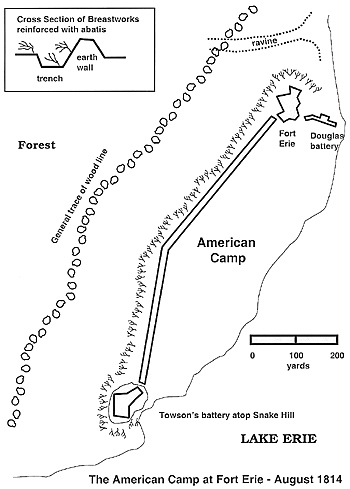Drummond slowly brought the Americans under siege. Brown retained overall command from his sick bed on the American shore. It appeared to Brown that he must build up his army quickly. He asked New York militia Major General Amos Hall to call up one thousand militiamen. Hall issued an immediate draft for the required numbers. Brown sent word to his friend and political ally Governor Daniel Tompkins to call up between three and four thousand more. “This state has suffered in reputation in this war; its militia have done nothing or but little, and that, too, after the state has been for a long time invaded” the former militia brigadier confided. “I find the inhabitants of this frontier more disposed to skulk from the danger that threatens them, than to arise in defense of their country and her rights” he continued.
Brown's lowly estimation proved correct; eighteen days later only three hundred New Yorkers had responded to Hall's draft. Brown requested that the Governor place all militia on the Niagara Frontier under Brigadier General Peter B. Porter. “I have found his mind cool and collected, and his judgment to be relied upon” remarked Brown. When Tompkins read Brown's letter, he also had one before him from a disgruntled Porter. “But it is certain that no militia general is to gain any fame while united to a regular force and commanded by their officers,” Porter complained. He was perturbed by Brown's order to attack at dawn on the day following Lundy's Lane as well as by Ripley's “precipitate retreat” to Fort Erie.
With Brown and the unbearable Scott both away, Porter was now second-in-command of the Left Division. But his hopes of ever commanding the division were crushed when he learned that Brown had sent for Gaines to replace Ripley. “In short,” Porter grumbled, “I have been brigadiered till I am quite satisfied.” His offer to resign his commission and the command of his “ragged, unprovided, and undisciplined” brigade was ignored by Governor Tompkins.
 Map - The American Camp at Fort Erie - August 1814
Map - The American Camp at Fort Erie - August 1814
Meanwhile, in Buffalo an incident occurred that shed light on the state of native affairs. Having reached an agreement with the Grand River Indians to mutually withdraw from active warfare, the Senecas living near Buffalo were dismayed to discover a Canadian Indian spying on the Americans. Confronting this covert agent on the streets of the town, a group of Senecas surrounded him while one of their elders, Farmer's Brother, summarily executed him with a pistol shot. They then carried the corpse from the city. When told the circumstances of the murder, town officials chose to ignore the incident. The New York Iroquois had not entirely abandoned their American allies.
Drummond opened a bombardment of Fort Erie and the adjoining American entrenched camp. He also planned a three-pronged night attack. The main attack would enter the American camp on the west along the shores of Lake Erie while two supporting attacks aimed directly at Fort Erie on the Northeast. Expecting such an occurrence, Gaines had positioned the units of the Division so as to intersperse regulars with militia. Starting at the southern end of the camp and moving clockwise around the perimeter, he placed Ripley's Second Brigade, Porter's Third Brigade, and the First Brigade commanded now by Lieutenant Colonel Thomas Aspinwall.
From the Second Brigade, the 21st Infantry was responsible for the gap between Lake Erie and Snake Hill - the point of the British main attack. Towson's artillerists defended their battery on the hill and the 23rd Infantry defended a short line of the breastworks to the right of Towson's Battery. The majority of the long breastworks was manned by Porter's Brigade reinforced by the First and Fourth Rifles. Inside Fort Erie, artillery Captain Alexander J. Williams commanded sixty gunners and six cannon. Major William A. Trimble led two companies of recruits of his regiment, the 19th Infantry, which reinforced the artillerists. From Fort Erie to the shore was the First Brigade reinforced by two companies of volunteers from Porter's Brigade. In the middle of the First Brigade was Douglass's Battery manned by the company of bombardiers from West Point. Gaines stationed his versatile engineers, William McRee and Eleazar Wood, along the northern and southern defenses respectively. McRee commanded a cannon and Wood led four companies of the 21st Infantry. Pickets were put out in the woods to give early warning of attack. Gaines himself walked the entire perimeter encouraging the men and passing instructions to senior officers. Altogether Gaines had about 2600 men, mostly veterans, awaiting the British onslaught.
Overshadowed Heroes Part III: The Siege of Fort Erie
Part II: Chippawa and Lundy’s Lane
Part I: Third Brigade of the Left Division
Back to Table of Contents -- War of 1812 #3
Back to War of 1812 List of Issues
Back to MagWeb Magazine List
© Copyright 2002 by Rich Barbuto.
This article appears in MagWeb (Magazine Web) on the Internet World Wide Web.
Other military history articles and gaming articles are available at http://www.magweb.com